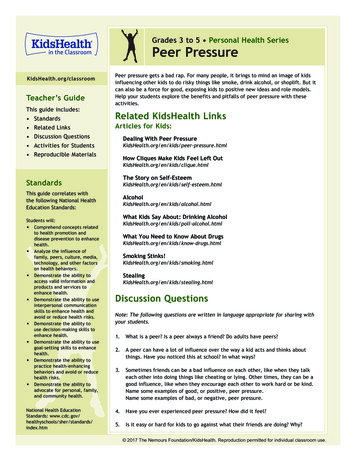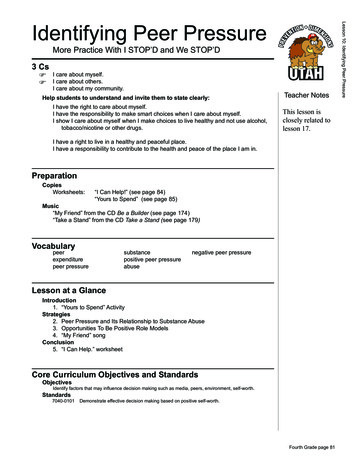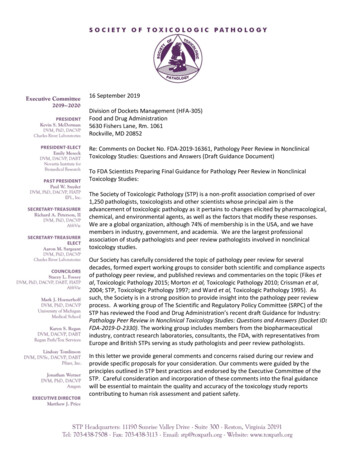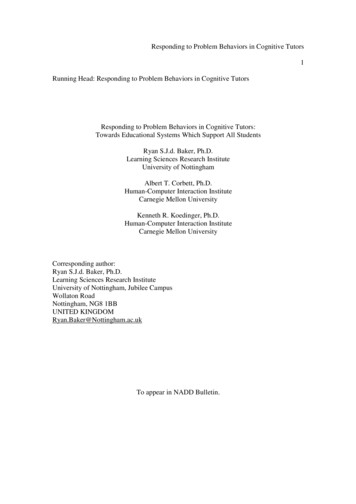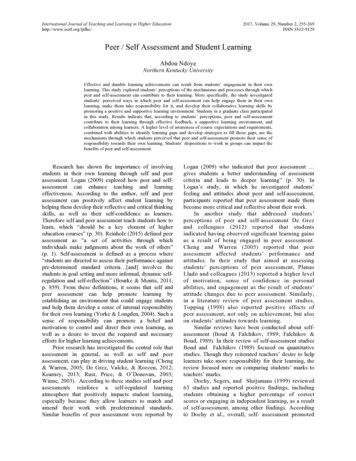
Transcription
CHAPTER NINECurriculum-Based PeerTutors and WACMARGOT SOVENLa Salle UniversityAt the dawn of the new millennium. writing across the cur riculum (WAC) is undergoing a transformation. The facultyworkshop that used to be the mainstay of WAC no longer existsat many institutions with established programs or even at schoolsabout to start WAC programs. In the first group of schools. fac ulty have already attended at least one workshop and perhapsalso participated in follow-up meetings. These instructors arefamiliar with the basic principles of WAC. such as using writingas a teaching tool and encouraging students to engage in all phasesof the writing process. but they often need additional support toimplement these ideas. And schools with new WAC programsthat are trying to introduce WAC concepts and strategies oftenlack the funding for faculty workshops.Enter peer tutoring as the new mainstay of many WAC pro grams. In the early days of WAC. peer tutoring was often re garded as a support service and was confined to the writing center.As a consultant evaluator for the Council of Writing ProgramAdministrators. when invited by a school to evaluate its WACprogram I would routinely ask. "Do you have a writing center?"I wanted to be sure that students who could not get sufficienthelp from their instructors-because their instructors lacked ei ther the expertise to deal with common writing problems. espe cially at the sentence level, or the time to meet with students afterclass-had a place to go. In those days. it was the peer tutor'sjobto supplement classroom instruction in writing and to meet withweak writers who required a great deal of assistance.- 200
Curriculum-Based Peer Tutors and WACBut times have changed, as Joan Mullin points out in Chap ter 8, "Writing Centers and WAC." The writing center plays anincreasingly important role in the WAC program. The peer tu tors who often staff writing centers not only help students withgeneric writing problems, but they also help them learn the rhe torical and stylistic features of writing in different disciplines.Increasingly, faculty come to the writing center for workshopsand informal conversations about writing.But the most dramatic change in the role of the peer tutorvis-a.-vis WAC is the emergence of curriculum-based peer tutor ing programs. Joan Mullin describes the courses in these pro grams as "tutor-linked courses." In this chapter, I demonstratehow the development of these programs coincided with the evo lution of the WAC movement. I point out how the role of thecourse-linked peer tutor differs from the role of the writing cen ter peer tutor, and how ongoing controversies related to peer tu toring also affect curriculum-based peer tutoring programs, fromhere on referred to as CBPT programs. The chapter concludeswith some practical information about choosing, training, reward ing, and supervising peer tutors in CBPT programs and a briefdiscussion about evaluating such programs.Many CBPT programs are the descendants of the BrownUniversity Writing Fellows Program, although Brown was notthe first school to assign undergraduate writing tutors to courses.Harriet Sheridan pioneered the idea of linking peer tutoring toWAC programs at Carleton College and then helped to establisha similar program at Brown. The credit, however, goes to ToriHaring-Smith of the English department at Brown University forpopularizing curriculum-based peer tutoring. Once Haring-Smithgot the Brown program started in the early 1980s, with Sheridan'sassistance, she invited faculty and tutors from other schools topeer tutoring workshops and conferences at Brown. Those of uswho participated marveled at the enthusiasm of both Brown fac ulty and students for this new program. Although Haring-Smithhad initiated CBPT to develop a WAC program at a researchuniversity where faculty did not relish the idea of attending WACworkshops, other schools (such as La Salle University) that al ready had WAC programs saw the potential of CBPT as an in vigorating agent in existing WAC programs.- 201
MARGOT SOVENThe eight objectives of the Writing Fellows Program at BrownUniversity are similar to the principles and practices endorsed bymost WAC programs:To demonstrate that all faculty and students share responsibilityfor writing.To explore ways in which writing and learning are connected.To change both student and faculty attitudes towards writing.To make writing an integral part of the curriculum, not a feature ofisolated courses.To encourage students to practice good writing habits, includingrevision.To involve all students, not just weak writers.To reward faculty for their attention to student writing.To provide students with feedback for revision before their writingis judged and graded. (Haring-Smith 177).It was clear to those of us who directed WAC programs thatby placing peer tutors in the classroom we could give facultymembers a "WAC buddy." Tutors would become our emissaries,our intermediaries, with the special strengths that only peer tu tors can bring to the table. Those of us who started CBPT pro grams have not been disappointed. Karen Vaught-Alexander atthe University of Portland, in her response to an e-mail survey Iconducted in 1997, calls her course-linked tutors "'gentlesubversives' who have created more change in the departmentsthan any faculty workshop on clear writing assignments." Bar bara Sylvester at Western Washington University says, "My Deanof General Education/Honors mentioned the other day that whenhe visits other departments they are often holding discussionsabout writing. He said that ten years ago writing was not a topiCof conversation on campus." Deidre Paulsen describes writingfellows as "unintimidating catalysts for discussion about writingat all levels because they are a safe sounding board for profes sors; they clarify writing for students entering majors throughtheir workshops; they help students clarify their thinking through- 202
Curriculum-Based Peer Tutors and WACtheir mentoring, and in the process of translating for everyoneelse, their own writing improves." She goes on to say.They have caused whole departments (from engineering to reli gion) to sit down to ponder appropriate assignments and some times ask help drafting them. Whereas once we brought in WACconsultants (and I wish we still could), today we recognize thatover the long haul, Writing Fellows are there for the entire se mester or longer to support a faculty member as she experimentswith various kinds of write to learn as well as transactional as signments. (Soven, "Writing")It is interesting to note that as early as 1904 there are ac counts of the success of one-on-one classroom writing instruc tion, at that time called the "laboratory approach." Teachers,not peer tutors, were working one on one with students, but fromthe beginning they were advised to behave like peers. In an essayby an instructor on the subject of the lab approach, he reportswith obvious satisfaction that one of his students said, "You aren'tthe dignified teacher I used to think you were. You seemed likeone of the boys, and I have learned to like English in laboratorywork." The value of an approach to CBPT in which the teacherwas less authoritarian was beginning to be recognized (Carino104)One-on-one classroom instruction had more in common withCBPT than with writing center tutoring programs. Most impor tant, its goal was not remedial. An students had the opportunityfor lab instruction when teachers reviewed their papers at differ ent stages during the writing process. Writing centers began witha similar agenda, but rapidly became places for remediation inorder to accommodate the needs of underprepared students, es pecially during the influx of college students after World War IIand during open enrollment in the 1960s (see Mullin, Chapter 8,this volume).In "The Politics of Peer Tutoring," one of the first essays toappear on CBPT, Kail and Trimbur point out that originally CBPTprograms were attached to the first-year composition program,the curriculum-based model providing a required lab componentin writing courses. Students worked one on one with a peer tutor- 203
MARGOT SOVENas part of their course work. Some schools still reserve classroomtutors for courses in the writing program. At the City College ofNew York, for example, tutors from the campus writing centerare each attached to a section of composition (Soliday). In thelast fifteen years, however, CBPT programs not only expandedto other disciplines as WAC programs grew, but some also incor porated activities beyond reading drafts and conferencing. Forexample, peer tutors often coordinate with the course instructorto provide in-class tutoring. At La Salle University, course-linkedtutors, called writing fellows, are occasionally asked to conductdiscussions about or give classroom presentations on commonerrors. In any case, in the curriculum-based model, peer tutorsare written into the plan of instruction. They are part of the course,which gives them a distinctly different role than that of the writ ing center tutor.The Brown University workshops led to the establishment ofCBPT at a diverse group of schools. Large state institutions (e.g.,Western Washington State University, Illinois State University),Ivy League institutions (e.g., the University of Pennsylvania,Barnard University), and liberal arts colleges (e.g., SwarthmoreCollege, Lafayette College) began to recruit faculty and studentsfor their own CBPT programs.In a survey I conducted in 1993, I found that the largest num ber of responding curriculum-based peer tutoring programs con form to the Brown model (Soven . Curriculum-Based "). At theseschools, tutors are selected from all fields. They receive trainingand are assigned to courses in a variety of disciplines where theyread the drafts of all the students in the course, the theory beingthat all students, not just the weak writers, can benefit from draftreview. This is also a major tenet of WAC programs, stronglyendorsed by modern composition theory and research. In manyprograms, tutors give both written and oral feedback, usuallymeeting with their students after having read the drafts. The tuteeis free to accept or reject the tutor's comments. Some schoolsassign peer tutors to special projects rather than to courses. AtSeattle University, for example, course-linked tutors work withstudents in the School of Engineering on special projects. At LaSalle University, the Biology department assigns tutors to the se nior writing project. In all cases, whether they are assigned to- 204
Curriculum-Based Peer Tutors and WACcourses or department projects, course-linked tutors reinforce theidea that revision is an integral part of writing in all courses.CBPT and the Peer Tutoring ControversyAs CBPT becomes more popular, old controversies about peertutoring have resurfaced, along with new questions specific toCBPT programs and the role of the peer tutor in the context ofWAC. Perhaps because in CBPT programs the tutor is built intothe plan of instruction, these questions have assumed even greaterimportance than in the past, when most peer tutors were assignedto writing centers. Both instructors and students can ignore thepeer tutor in the writing center, an impossibility with the course linked tutor. Typically she has been assigned to a course for thesemester at the request of the instructor. It is understood that thetutor will work with all of the students in the course that semes ter. Karen Vaught-Alexander at the University of Portland tellsher course-linked tutors to think of themselves as part of a teaminvolving the client, the tutor, and the faculty. The coordinatorof the CBPT program is also a part of that team. At the begin ning of the academic year, I tell the writing fellows at La SalleUniversity and their sponsoring instructors, "We are all in thistogether. Therefore, only by working together can we make thisprogram a success. "The close working relationship between the teacher, the stu dent, and the peer tutor forces us to revisit the questions underly ing all controversies about peer tutoring: What is the appropriaterole of the peer tutor in relation to the teacher and the students?How does the tutor's role differ from the instructor's role? Whatkind of help and how much help should tutors proVide for stu dents? Mary Soliday, in her essay "Shifting Roles in ClassroomTutoring," notes that in the early stages of an experimental pro gram involving course-linked tutors, "students, teachers, andtutors alike had trouble 'placing' the tutor within a classroom'shierarchy and defining the tutor's role" (59). Theorists and re searchers who study peer tutoring, and instructors who workclosely with peer tutors, continue to grapple with this issue. Manypeer tutoring theorists (e.g., Bruffee; Goodlad and Hirst) believe- 205
MARGOT SOVENthat the tutor's strength resides in his special peer relationshipwith the students. In their view, to maintain that relationship thepeer tutor must disassociate himself from the instructor and be"non-judgmental and non-directive" as opposed to the teacherwho is "directive and evaluative" (see Raines). Raines argues,however, that this is a false dichotomy and recommends that con versation about this issue be conducted as a dialectical exchangebetween the two positions. Raines says that during the last fif teen years we have learned that both the tutor and the instructorlearn from one another. Sometimes the tutor may need to be moredirective and judgmental, depending on the student, and fre quently the instructor may need to assimilate into her teachingstyle the less directive and less judgmental strategies of the peertutor.Some teachers, however, cannot see the role identificationissue in any but dualistic terms. They are apprehensive aboutsharing their authority with peer tutors and experience difficultyworking with a tutor who is more directive. In the CUNY pro gram described by Soliday, in which tutors were present in theclassroom, teachers found it difficult to share their authority withanother person and were concerned about the tutor's criticism oftheir performance. At La Salle University, instructors who find itimpossible to relinquish authority to peer tutors usually with draw from the program after a semester. This happens rarelybecause most of the instructors who request a writing fellow havebeen participants in our Writing-Across-the-Curriculum work shop and they have, or have" converted" to, theories about teach ing revision that emphasize the value of peer review.Some instructors would like the peer tutor to behave as afaculty clone, an understudy who fills in for the absentee teacherwhen writing comments on student drafts and conducting con ferences. For these instructors, the most effective tutor is the tu tor who is a good reporter-that is, he reports the instructor'smessages to the students. In this case, the tutor's authority torespond to the student's paper as a peer is seriously undermined.These issues of authority are symptomatic of how many in structors think about learning. Teachers who believe that learningis based on instructional delivery have a hard time relinquishing- 206
Curriculum-Based Peer Tutors and WACauthority. But those teachers who have been exposed to socialconstructivist theories of learning, which emphasize the impor tance of collaborative learning and conversation, are more apt toview the tutor as a valuable link in the learning process. Theseteachers often use some form of collaborative learning, such assmall-group discussion, in their classrooms.The main question when evaluating the success of any peertutoring program is, Which tutoring approach . better deliversthe knowledge it takes to learn to write well?" (Kail and Trimbur7). When we ask that question in the context of the goals ofwriting across the curriculum, we use as criteria for the program'ssuccess more than the quality of the completed paper. We arealso interested in knowing whether the students being tutoredhave increased their competency in several areas: their under standing of the writing process, the ability to use writing as alearning tool, knowledge of the rhetorical conventions of aca demic discourse in a variety of disciplines, and the acquisition ofa vocabulary for talking about writing. We continue to debatewhich role is most effective for the tutor to adopt to help stu dents acquire these competencies and how to help tutors developthis role.When WAC and CBPT are related, the issue that receives themost attention is the effectiveness of the generalist versus the spe cialist peer tutor. In "Look Back and Say 'So What': The Limita tions of the Generalist Tutor," Kiedaisch and Dinitz argue for thebenefits of tutors who know the subject matter of the diSCiplinein which they are tutoring writing. After videotaping twelve tu toring sessions, they concluded that only those tutors familiarwith the discipline in which the student was writing could askquestions that would improve the quality of the analysis in apaper, though knowledge of the diScipline did not always guar antee that the tutor could help a student achieve this goal. Thetutors' general knowledge about academic writing did not helpstudents writing literature papers move beyond plot summary.The students who were being tutored never arrived at a "con trolling insight" for their papers, and their ideas seemed randomlyordered, although each idea was well developed. Furthermore,some tutors had difficulty applying the general tutoring strate - 207
MARGOT SOVENgies they had learned when working with unfamiliar discipline specific assignments. Despite these drawbacks, however, studentswho worked with generalist tutors still rated their sessions withthe tutor very positively. Kiedaisch and Dinitz say,We know we can't reach conclusions based on this small numberof cases, but in the sessions we looked at, the tutor's knowledgeof how to think and write in a discipline did seem important.Good tutoring strategies were not enough. All these tutors weretrained to address global before local concerns, to use question ing to draw out students' ideas, and to refrain from appropriat ing the student's paper. All of them had had numerous tutoringsessions with students in introductory writing courses in whichthey had successfully demonstrated these strategies. But David,Michelle, and Jill [peer tutors in the studyJ seemed unable toapply [these strategies] when working with students on assign ments other than [those in] their own [major]. (72)Not at all discouraged by their findings, Kiedaisch and Dinitzdraw three conclusions, which directors of CBPT programs shouldtake to heart:1. We feel if students are satisfied and motivated they have ben efited. A session that is less than it can be is not a bad session2. In many cases assignments do not require a knowledgeable tu tor, especially assignments in introductory courses.3. Even when tutors cannot help students master the thinking pat terns or rhetorical patterns of writing in a diSCipline, they canhelp instructors teach them these skills by explaining to the fac ulty what they have learned about student difficulties (73).Kiedaisch and Dinitz discovered that tutors who are not familiarwith disciplinary conventions might still help students learn aboutthe writing process; although these tutors do not always ask allthe right questions, they demonstrate that asking questions helpsthe tutees build audience awareness. Kiedaisch and Dinitz's thirdfinding suggests that in addition to being accepted as peers bytheir tutees, tutors were also accepted as "authorities" by theirsponsoring instructors, especially on matters related to under standing the problems students faced when writing.- 208
Curriculum-Based Peer Tutors and WACThe discussion about the effectiveness of the generalist ver sus the expert peer tutor is further complicated by another con sideration-namely, does competency in one area of knowledgehinder the tutor's performance in another area? For example, inSusan Hubbuch's essay" A Tutor Needs to Know the SubjectMatter to Help a Student with a Paper: Agree DisagreeNot Sure," she argues that a tutor who is knowledgeableabout the subject matter being written about is apt to treat writ ing as a product rather than a process and therefore proceed totry to "fix" the paper. The peer tutor may ask the right questionsto help the student improve the content, but in doing so may givethe student too much direction, thereby encouraging the kind ofpassivity which will draw attention away from the process ofwriting. Hubbuch goes on to say that these expert tutors maypersuade students that all rhetorical decisions are either right orwrong rather than explaining to them that some rhetorical deci sions are simply better than others in any given communicationsituation.While Hubbuch acknowledges some of the benefits associ ated with tutoring in the major, she believes that the negativeeffects far outweigh them. Because she believes that passivity isthe greatest obstacle to effective writing, Hubbuch argues thatthe tutor's ability to motivate the tutee to take charge of her ownwriting is more apt to be compromised by the knowledgeabletutor.Haring-Smith is one of the strongest supporters of the gener alist tutor model. She argues that "only with courses relyingheavily on technical vocabulary or foreign language courses mustthe writing fellows have a particular expertise; the writing fellowin most courses acts as an educated lay reader, who can honestlyreport when she is confused by what a student is trying unsuc cessfully to say" (179). For Haring-Smith, the expert tutor cansubvert the goals of peer tutoring. Assigning peer tutors to coursesoutside their majors became an important part of the Brown credo.Haring-Smith's discussions about peer tutoring emphasize themission of the peer tutor to promote one of the major objectivesof WAC--to use writing as a tool for clarifying what studentswant to say about the course content, thereby reinforcing theidea that writing is a tool for learning the course content.- 209
MARGOT SOVENKenneth Bruffee, one of the earliest proponents of collabora tive learning in writing instruction, places more emphasis thanHaring-Smith on the ability of the peer tutor to teach the con ventions of thinking and writing in the disciplines. For Bruffee,however, disciplinary knowledge does not detract from the peertutor's role as a peer, nor does it interfere with imparting knowl edge about writing. The two issues are not connected for Bruffee;he defines a tutor's knowledge of the content and the rhetoric ofa discipline in process-oriented terms. When speaking to a groupof peer tutors at Brown University in 1993, Bruffee said,What you do as a tutor, as I understand it, is to help a tutee crossthe boundary between one knowledge community and another.You do that by helping the tutee learn the language of the newcommunity. Knowledge communities, or if you prefer, discoursecommunities, are groups of people who talk the same way. Theboundaries between knowledge communities are defined by thewords, turns of phrases, and styles of speaking and writing thatcommunities agree on as they construct the knowledge that istheir common property. (3)Bruffee considers this to be a constructive process. The tutor doesnot tell or show the tutee this language but, through conversa tion, helps the tutee understand these new languages and use them.He says, "My premise here, then, is that the most important ex pertise you gain in learning to be a peer tutor is the linguisticflexibility required for helping students translate from one lan guage to another-from the languages you and your tutees speakto languages that the faculty speak" (3). In Bruffee's view, con versation is an integral part of the process of learning how towrite, and therefore discipline-specific knowledge facilitates learn ing how to write by increasing the effectiveness of the conversa tion between tutors and their tutees.Bruffee's theories about peer tutoring mesh well with WACtheory, which emphasizes the connections between form and con tent in writing. Many WAC theorists believe language is not sepa rate from content, but is content. This is where there is a. disconnect" between WAC theory and the guidelines adoptedby many peer tutoring programs, based on the Brown program- 210
Curriculum-Based Peer Tutors and WACand WAC theory. In the program at La Salle (described in a latersection), I no longer worry about peer tutors commenting oncontent, but I stress the fine line between enabling students torevise their work and revising their work for them.Curriculum-Based Programs: Progress and ChangeIn the early years of curriculum-based peer tutoring programs,most programs followed Brown's approach of assigning tutorsto courses outside their major. My 1997 e-mail follow-up surveyof some of these programs indicates, however, that these pro grams have either become more flexible or they have completelyabandoned this practice. The program directors I surveyed agreethat knowledge in the discipline is an important factor when as signing tutors, but they take into account other variables as well.Western Washington University, Brigham Young University, andLa Salle University's approaches are representative of the depar ture from the Brown model.Western Washington UniversityAt Western Washington University, writing fellows work withthe required 300-1evel writing proficiency courses. Knowledge able tutors are assigned to their majors only in science courses.First-year tutors are aSSigned to courses that best match theirparticular strengths, which might include knowledge in a disci pline but can also mean their writing ability or their interper sonal skills. Experienced writing fellows choose courses thatinterest them. Barbara Sylvester. the director of this program.reports that "these Fellows have demonstrated for some ten yearsnow effective but different ways to comment on student papers.certainly one factor in the present groundswell to create moresystematic and comprehensive approaches to writing for studentsapproaching their major" (Soven. "Writing"). She believes thatknowledgeable peer tutors do not necessarily sacrifice the tradi tional role of the peer tutor. Once they understand their role. thetemptation to be overly directive is not as strong.- 211
MA RGOT SOVENBrigham Young UniversityBrigham Young University assigns students to courses in theirmajor. Deidre Paulsen, the director of that program, says,I started out following Brown University's dictum-somethingwritten well should be clear to any educated lay audience. I'msure that guide can work at a liberal arts college (except perhapsin philosophy) but we have too many profeSSional programs atBYU for it to work well. After having my WF's become quiteintimidated by fellowing in a philosophy 400 course, and in anengineering course, I now ask specialized departments to recom mend students in their fields for me to train, so they can be trainedto work in that field.Paulsen, while recognizing the pitfalls in assigning knowledge able peer tutors to advanced courses, believes that the benefitsoutweigh the limitations. Although she agrees with Haring-Smith'sconcern about commenting on course content, she uses Bruffee'sterminology to discuss the role of her tutors. According to Paulsen,"my Writing Fellows serve as visiting archeologists to translatevarious cultures to the students who are confounded by the cul tural differences in disciplines" (Soven, "Writing"). Like manycoordinators of peer tutoring programs, Paulsen finds some theo retical statements more useful than others for describing her pro gram.La Salle UniversityLa Salle University assigns tutors to advanced courses in theirown field of study, but we often do the same for introductorycourses. After thirteen years directing a curriculum-based peertutoring program, during which time I have trained and super vised more than 250 tutors, I have come to believe that the knowl edgeable tutor--that is, the tutor who is familiar with the subjectmatter of the course more effectively communicates the vari ous understandings about writing promoted by WAC than thegeneralist tutor, the tutor who is unacquainted with the coursecontent. In all these years, we have had only one tutor whoseknowledge of the subject matter clearly jeopardized his role as a- 212
Curriculum-Based Peer Tutors and WACpeer tutor. This writing fellow was viewed by the students hetutored as impatient and arrogant. Instead of falling into the typi cal trap of knowledgeable peer tutors-i.e., giving his students toomuch help because he saw them as "hopeless" -he tended to beabrupt and condescending. Fortunately, his was an isolated case.More studies similar to the one by Kiedaisch and Dinitz areneeded. Until more systematic research on the effectiveness ofthe knowledgeable tutor is conducted, however, we must rely onsurveys and reports of instructors, students, and the peer tutorsthemselves. Thirteen years of these internal evaluations at La SalleUniversity indicate that most teachers, tutors, and students be lieve that the program is more successful with knowledgeabletutors, though they praise the efforts of generalist tutors as well.The knowledgeable tutor is more necessary in advancedcourses than introductory courses, in which the papers assignedare sometimes (but not always) of a more general nature. At LaSalle, I usually assign new tutors to introductory courses becauseassignments are often not discipline specific and the expectationsof instructors in different disciplines are similar. For example,the book review is a common asSignment in history, philosophy,and religion classes. Most instructors want a brief summary ofthe text, followed by a critique based on general criteria, such aspersonal interest and cl
Ivy League institutions (e.g., the University of Pennsylvania, Barnard University), and liberal arts colleges (e.g., Swarthmore College, Lafayette College) began to recruit faculty and students for their own CBPT programs. In a

